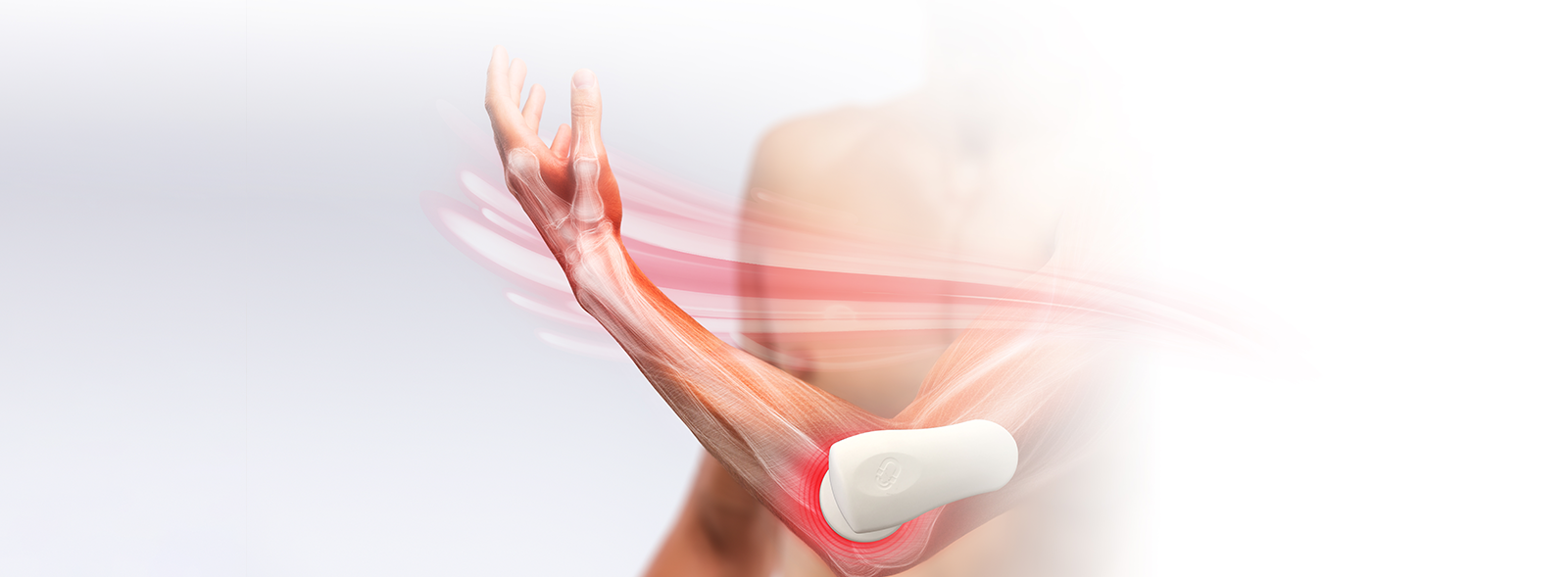How do you treat tennis elbow?
Blog 1 in a series of 3

There is no consensus on the best treatment for epicondylitis lateralis, or tennis elbow, although there are many different methods. In a series of three blogs, we will discuss eight successful approaches. Each treatment involves the motivations of a physical therapist and the experience of a patient. Which techniques are indicated for your patient, in which combination, depends on each patient and the extensiveness of their complaint.
In this first blog, we discuss two treatment methods, patient load reduction and TECAR therapy. Before going into more detail about these treatments, allow us to briefly describe how to recognise tennis elbow.
Symptoms of epicondylitis lateralis
Patients with tennis elbow often experience the following symptoms:
- Pain at the lateral epicondyle with possible radiating pain to the index and middle finger
- Tense and/or painful wrist extensors
- Pain and/or difficulty with wrist extension, pinching, wringing and reaching
- Sometimes painful and/or limited elbow extension
The problem affects 1-3% of adults annually, particularly people between the ages of 45 and 54. Women account for a slightly larger proportion than men. In fact: 20% of women in this age group endure some form of lateral elbow pain1. Fortunately, there are ways to reduce the pain and limitations for patients. The best start is always to tackle load.
Reducing load in tennis elbow
Since overuse is at the root of this complaint, it is wise to reduce and/or limit the strain on the affected tendons. The patient benefits from additional knowledge.
Physiotherapist Maartje: "The more the patient knows, the better they can adjust their own provocative movements. That's why I always start with a brief explanation of anatomy, about the balance between load and load capacity and tips and advice in this area."
Next, it is helpful to go over a number of specific movements and possible adjustments with the patient. Maartje: "We go over the provocative movements together and look for alternatives so that the tendons get more rest. For example, overhead lifting can be replaced by underhand lifting and reaching can be done with the other arm."
Patient William has come a long way with these basics: "I learned which movements involve too high a load and the ways I can lighten that load. Now, if I feel pain during a movement that we haven't looked at yet in therapy, I can judge fairly well how to adjust that movement. Not only do I like the fact that my elbow is less painful because of this, but I also like the fact that it immediately makes me a little less dependent on my physiotherapist."
TECAR therapy in case of an epicondylitis lateralis
TECAR therapy is a form of combined contact diathermy and electrotherapy. Its application promotes the body's own healing process, significantly shortening the recovery time for acute and chronic conditions.
We spoke with physiotherapist Killian about his choice of TECAR therapy for patients with tennis elbow.
Killian: "I invariably use TECAR therapy with my patients as part of the treatment of tennis elbow. In addition to the pleasant diathermic effects that provide muscle relaxation and pain relief, the current effect also contributes to faster tissue recovery. My patients can get back to work faster in a responsible way."
In contrast to shockwave, TECAR therapy can be used for acute inflammatory processes, as in the case of acute tennis elbow. And as a case report from Stasinopoulos shows, the positive results are there: after a five-day treatment with twice-daily TECAR therapy, a 46-year-old man with acute epicondylitis lateralis experienced an improvement on his VAS pain from 9 to 2 and on his VAS function from 1 to 7.2 Patient Augustine recognises this success:
"As on a previous occasion with shoulder tendon complaints, the treatment with TECAR chosen by my physiotherapist gave me almost immediate results for the treatment of my tennis elbow. The stabbing pains on the outside of my elbow have clearly eased after only two treatments, I can squeeze better with my affected hand and I can get a good night's sleep again.''
More information about TECAR therapy
Do you think that TECAR therapy could be effective in one or more of your patients and would you like to receive more information and/or a personal consultation? Please feel free to contact us.
1 Sanders TL Jr, Maradit Kremers H, Bryan AJ, Ransom JE, Smith J, Morrey BF. The epidemiology and health care burden of tennis elbow: a population-based study. Am J Sports Med. 2015;43(5):1066-1071. doi:10.1177/0363546514568087
2 Stasinopoulos, Dimitrios. (2019). The effectiveness of 448 kHz capacitive resistive monopolar radiofrequency in acute Lateral Elbow Tendinopathy. A case report. 4. 1613.
